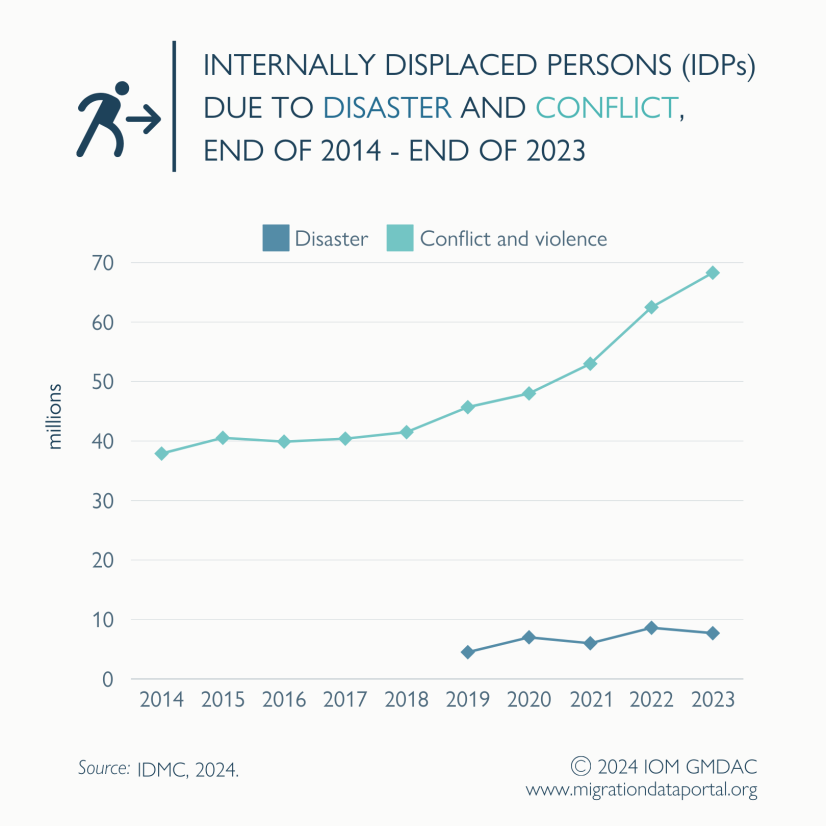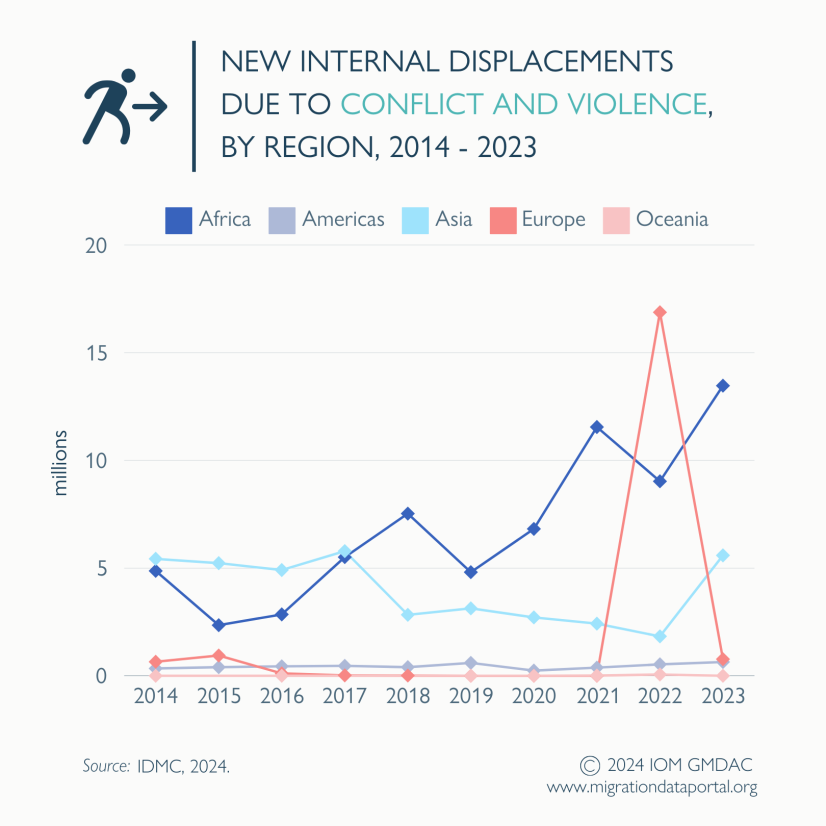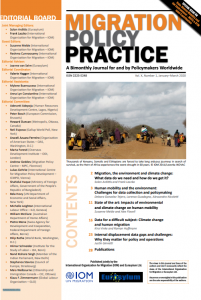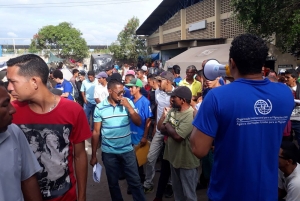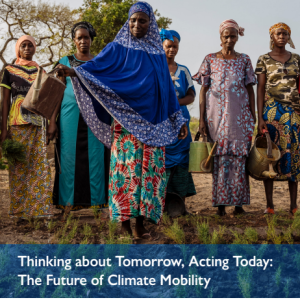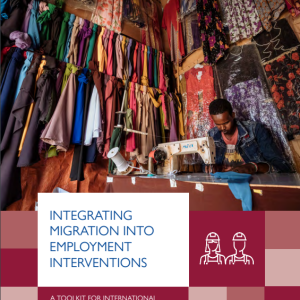Forced migration or displacement
In studying forced or involuntary migration a distinction is often made between conflict-induced and disaster-induced displacement. Displacement induced by conflict is typically referred to as caused by humans, whereas natural causes typically underlie displacement caused by disasters. The definitions of these concepts are useful, but the lines between them may be blurred in practice because conflicts may arise due to disputes over natural resources and human activity may trigger natural disasters such as landslides. Although conflict and disaster are the main drivers of forced displacement, other drivers include urbanization, generalized violence and human rights violations, among others.
Countries collect data on displaced people – forced to move by humans or nature, and displaced internally or internationally.. Such data are typically collected through a combination of population censuses, household surveys, border counts, administrative records, and beneficiary registers. Even within the same country, different government ministries may collect different types of data on displaced people, using different methods and for different purposes.
At the international level, data on forced migration are collected and/or compiled by various intergovernmental organizations (IGOs), such as the Office of the United Nations High Commissioner for Refugees (UNHCR) and the International Organization for Migration (IOM), as well as non-governmental organizations (NGOs), such as the Internal Displacement Monitoring Centre (IDMC).
Definitions
Key terms that are used in the context of forced migration or forced/involuntary displacement include:
According to IOM, forced migration is “a migratory movement which, although the drivers can be diverse, involves force, compulsion, or coercion.”1 The definition includes a note which clarifies that, “While not an international legal concept, this term has been used to describe the movements of refugees, displaced persons (including those displaced by disasters or development projects), and, in some instances, victims of trafficking. At the international level, the use of this term is debated because of the widespread recognition that a continuum of agency exists rather than a voluntary/forced dichotomy and that it might undermine the existing legal international protection regime.” (IOM Glossary on Migration, 2019).
Displacement, according to IOM is “the movement of persons who have been forced or obliged to flee or to leave their homes or places of habitual residence, in particular as a result of or in order to avoid the effects of armed conflict, situations of generalized violence, violations of human rights or natural or human-made disasters. (IOM, 2019)
According to the 1951 United Nations Convention relating to the Status of Refugees and its 1967 Protocol refugees are persons who flee their country due to "well-founded fear" of persecution due to reasons of race, religion, nationality, membership of a particular social group or political opinion, and who are outside of their country of nationality or permanent residence and due to this fear are unable or unwilling to return to it. UNHCR includes “individuals recognized under the 1951 Convention relating to the Status of Refugees, its 1967 Protocol, the 1969 Organization of African Unity (OAU) Convention Governing the Specific Aspects of Refugee Problems in Africa, those recognized in accordance with the UNHCR Statute, individuals granted complementary forms of protection, and those enjoying temporary protection. The refugee population also includes people in refugee-like situations." (UNHCR, 2017).
Persons in a refugee-like situation includes “groups of persons who are outside their country or territory of origin and who face protection risks similar to those of refugees, but for whom refugee status has, for practical or other reasons, not been ascertained.” (UNHCR, 2013).
According to UNHCR, asylum-seekers are “individuals who have sought international protection and whose claims for refugee status have not yet been determined” (2017, 56).
Internally displaced persons (IDPs) are defined as “persons or groups of persons who have been forced or obliged to flee or to leave their homes or places of habitual residence, in particular as a result of or in order to avoid the effects of armed conflict, situations of generalized violence, violations of human rights or natural or human-made disasters, and who have not crossed an internationally recognized State border.” (Guiding Principles on Internal Displacement, E/CN.4/1998/53/Add.2.).
UNHCR introduced the category “other people in need of international protection” to reporting in mid-2022, to encompass “people who are outside their country or territory of origin, typically because they have been forcibly displaced across international borders, who have not been reported under other categories (asylum-seekers, refugees, people in refugee-like situations) but who likely need international protection, including protection against forced return, as well as access to basic services on a temporary or longer-term basis”. This category now includes the previously designated category of “Venezuelans displaced abroad” and those not reported in other categories. Retroactive changes have been made in UNHCR’s statistics since 2018 (2023, p4).
Mixed movement (also called mixed migration or mixed flow) is “a movement in which a number of people are travelling together, generally in an irregular manner, using the same routes and means of transport, but for different reasons. People travelling as part of mixed movements have varying needs and profiles and may include asylum seekers, refugees, trafficked persons, unaccompanied/separated children, and migrants in an irregular situation.” (IOM Glossary on Migration, 2019).
Resettlement, according to IOM, is the “transfer of refugees from the country in which they have sought protection to another State that has agreed to admit them — as refugees — with permanent residence status.” (IOM Glossary on Migration, 2019). Resettlement programmes are carried out by both IOM and UNHCR.
Key trends
Forced displacement due to persecution, conflict, violence, human rights violations or events seriously disturbing public order
The total number of people forcibly displaced – both within countries and across borders – as a result of persecution, conflict, generalized violence, human rights violations or events seriously disturbing public order almost doubled over the past decade. While there were 59.5million forcibly displaced people as of the end of 2014 (UNHCR, 2015), the figure was 117.3 million by the end of 2023 (UNHCR, 2024). This is the highest number available on record and an 8 per cent increase from 2022, following the trend of annual increases for the last 12 years (ibid.). An estimated forty per cent of all forcibly displaced people at the end of 2023 were children.
UNHCR operational data estimates that forced displacement had likely already exceeded 120 million by the end of April 2024 (ibid.). The drastic increase of total forced displacement — both within countries and across borders. An estimated forty per cent of all forcibly displaced people at the end of 2023 were children.

Forced migration or displacement across national borders
The number of refugees in 2023 is triple as many as a decade ago. Seventy three per cent of all refugees under UNHCR’s mandate and other people in need of international protection come from the following five countries: Afghanistan (6.4 million), Syrian Arab Republic (6.4 million), Venezuela (6.1 million), Ukraine (6 million) and South Sudan (2.3 million) (ibid.). Nearly forty per cent of all refugees and other people in need of international protection are hosted in the following five countries: Islamic Republic of Iran (3.8 million), Türkiye (3.3 million), Colombia (2.9 million), Germany (2.6 million) and Pakistan (2 million) (ibid.). Among refugees and those in need of international protection, 69 per cent were in countries near their countries of origin, and 75 per cent were hosted in low- and middle-income countries.
In 2023, there were 3.6 million new individual asylum applications registered, an increase of a third from 2022. At the end of 2023, 6.9 million asylum-seekers’ claims were still pending a decision, and in 2023, 823,800 people were granted refugee status. Between 2018 and 2023, over 2 million children were born as refugees (an average of 339,000 per year). (ibid.).
Forced migration or displacement within national borders
By the end of 2023, 75.9 million people were living in internal displacement as a result of conflict and violence as well as disasters (the stock of internal displacements) (IDMC, 2024). Of this total, 68.3 million people in 66 countries and territories were internally displaced by conflict and violence (a 9% increase from 2022, and a 49% increase in five years), and at least 7.7 million people in 82 countries and territories were internally displaced by disasters (an 11% decrease from 2022, but still the third highest figure within the last decade) (ibid.).
In 2023, there were 46.9 million new internal displacements (new forced movement of a person within the borders of the country of their habitual residence recorded during the year) across 151 countries and territories (ibid.; IDMC, n.d.). Disasters triggered 56 per cent (26.4 million) of the new internal displacements recorded; the rest, about 20.5 million, were prompted by conflict and violence (ibid.). It is important to note that displacement by conflict and displacement by disaster cannot always be reliably distinguished because many people can be displaced for one reason, and then get displaced for a second or even third time by a different reason.
While new internal displacements due to conflict was 70 per cent higher in 2023 than the past decade's annual average, there were 28 per cent fewer internal conflict displacements in 2023 than in 2022 (IDMC, 2024). Approximately half of all internal conflict displacements in 2023 were reported in Sudan and the Democratic Republic of the Congo, with 6 million and 3.7 million respectively (ibid.). Other countries which experienced large numbers of new internal displacement due to conflict were the Occupied Palestinian Territory (3.4 million), Ethiopia (794,000), Ukraine (714,000) and Burkina Faso (707,000) (ibid.).
Disaster displacement in 2023 was the third highest figure in the last decade, even though there were one third fewer displacements due to weather-related hazards, partly resulting from La Niña’s end and El Niño’s onset. 77 per cent of the 26.4 million new disaster displacements in 2023 were the result of weather-related hazards such as storms, floods and droughts (ibid.). Almost a quarter of all internal displacements were due to earthquakes, especially those in Türkiye, Syria, the Philippines, Afghanistan and Morocco (ibid.).Learn more about disaster-induced displacement and environmental migration here.
IDPs tend to be more vulnerable than their host communities (IOM, 2023). Their children are less likely to be in school, and they are more likely to face obstacles in accessing health services, IDP households are less likely than their host communities to have adequate shelter or a stable income. Furthermore, the longer that IDPs are displaced, the less likely they are to return to their community of origin (ibid.).
Refugee resettlement
158,700 refugees were resettled in 2023, 39 per cent more than in 2022 (UNHCR, 2024)). However, this number is only 8 per cent of the estimated 2 million people globally who needed resettlement in 2023 (ibid.).
Visit the interactive dashboard for more data on the following:
- Internal displacement (conflict)
- Internal displacement (disaster)
- Total internally displaced persons (conflict)
- Total internally displaced persons (disaster)
- Refugees by destination (UN DESA estimates)
- Refugees from the country (total)
- Refugees in host country (total)
- Asylum seekers from the country (total)
- Asylum seekers in host country (total)
- Asylum/refugee policy
Data sources
Global
UNHCR collects and provides data on the following types of displaced persons: refugees (including those in a refugee-like situations), IDPs, asylum seekers, returned refugees, returned IDPs, individuals under UNHCR’s statelessness mandate, and other groups or persons of concern to UNHCR. UNHCR’s Statistics Database provides data disaggregated by persons of concern, year, country of asylum, origin, gender, age, legal status and resettlement. In addition, UNHCR annually produces six main publications with relevant statistics : Global Trends: Forced Displacement, Statistical Yearbooks, Mid-Year Trends, Global Appeal, and Global Report. UNHCR also began a statistics technical series of papers that “make available in a timely fashion research, developments and studies on a variety of topics relevant to the statistical work of UNHCR”.
As a global reference point for data on IDPs, the Internal Displacement Monitoring Centre (IDMC) compiles and disseminates secondary data relating to IDPs from sources including OCHCA and IOM’s Displacement Tracking Matrix (DTM) through its online Global Internal Displacement Database (GIDD). In addition, IDMC produces an annual Global Report on Internal Displacement (GRID), covering internal displacement worldwide due to conflict, violence and disasters. IOM produces the greatest volume of IDP data for countries and at the global level, particularly through the DTM with 100 data operations in 2023.
The United Nations Children’s Fund (UNICEF) presents data from UN DESA and UNHCR relating to migration, including forced migration specific to children. Data are disaggregated by country of asylum.
IOM collects forced migration data through the Displacement Tracking Matrix (DTM). DTM is IOM’s global data operationssystem used to track and monitor population mobility including displacement , and is active in 121 countries since 2004. DTM data are regularly captured, processed and disseminated to provide a quality and timely understanding of the movements and evolving needs of displaced populations and migrants, whether on site or en route. In 2022, a total population of over 137 million were monitored by DTM, including 51 million identified IDPs and 48 million returnees. DTM reports, datasets and online interactive resources are available from the DTM website. DTM is part of IOM’s Global Data Institute (GDI). In addition, IOM conducts and supports data production, analysis and research designed to guide and inform migration policy and practice, including collecting data on the number of migrants it assisted and resettled to States offering temporary protection or permanent resettlement and, since 2014, IOM reports on the number of people who went missing or died the process of international migration (Missing Migrants Project)..
The United Nations Office for the Coordination of Humanitarian Affairs (UNOCHA) manages the Humanitarian Data Exchange (HDX), an open platform for sharing data from a range of partners, which provides nearly 21,000 datasets over 250 locations.
The United Nations Children’s Fund (UNICEF) presents data from UN DESA and UNHCR relating to migration, including forced migration specific to children. Data are disaggregated by country of asylum.
EGRISS (Expert Group on Refugee, IDP and Statelessness Statistics)
The Expert Group on Refugee, IDP and Statelessness Statistics (EGRISS) is a multi-stakeholder group mandated by the UN Statistical Commission to develop international recommendations, standards and guidance for improved statistics in internal and international displacement and statelessness. Established in 2016, the expert group has supported countries and regional and international organizations to enhance the collection, production, use and dissemination of data and methods on displaced populations. As of late 2022, EGRISS membership consists of 56 national authorities (namely national statistical offices) and 36 regional and international organisations. Since 2018, EGRISS has produced international recommendations on IDP (IRIS), refugee (IRRS) and statelessness (IROSS) statistics.
Europe
Eurostat provides statistics on various international migration topics, including outcomes of forced migration to Europe. Through its database, Eurostat provides data on the number of refugees, asylum applications, decisions on asylum applications and resettlement, and Dublin statistics within Europe.
Middle East
The United Nations Relief and Works Agency for Palestine refugees in the Near East (UNRWA) provides assistance and protection for Palestinian refugees in Gaza, Jordan, Lebanon, Syria, the West Bank and the Gaza Strip. The UNRWA in Figures publication releases statistics on the number of Palestinian refugees and refugee camps. Today, over 5 million Palestine refugees have registered with UNRWA.
Americas
The Organisation for Economic Co-operation and Development (OECD) and the Organization of American States (OAS) together operate the Continuous Reporting System on International Migration in the Americas (SICREMI), which produces biannual reports of collected data from various sources in the Americas Region. The publication provides a short chapter on asylum seeking in the Americas, including data by country of asylum from 2001 to 2015.
The Coordination Platform for Refugees and Migrants from Venezuela (R4V), established on 12 April 2018, is led and coordinated by UNHCR and IOM. It is aimed at addressing the protection, assistance and integration needs of Venezuelan refugees and migrants in Latin American and Caribbean countries. The website provides cumulative data on pending asylum claims lodged by Venezuelans, recognized refugees from Venezuela and residence permits granted to Venezuelans.
The Worldwide Refugee Admissions Processing System (WRAPS), a system operated by the U.S. Department of State’s Bureau of Population, Refugees and Migration, provides statistics on refugee arrivals and admissions in the United States, by region, state and nationality. In addition, the Office of Immigration Statistics (OIS) produces Annual Flow Reports and Data Tables on refugee and asylum statistics, disaggregated by country of origin, age, sex and marital status.
The Government of Canada’s Immigration, Refugees and Citizenship Canada (IRCC) Department has an Open Government Portal through which information on immigration and citizenship programmes can be found. Specifically, the portal provides monthly statistics on asylum claims, Syrian refugees and resettled refugees.
Australia
The Australian Government provides statistics on their humanitarian programme, which include quarterly asylum statistics and yearly asylum trends as well as yearly outcomes for their Offshore Humanitarian programme (refugee visas) and monthly irregular maritime arrivals reports.
Data strengths & limitations
Given the high public interest in forced migration (displacement), timely, quality and meaningful data are essential. Existing data provide an indication of refugee and IDP figures globally, but data are collected through varying methods and may represent only estimates and perceptions, not providing complete overviews of all population movements within a location.. Data discrepancies can occur due to disaggregation by country of origin or country of asylum only. Often data are lacking information on sex and age.
As one of the largest sources for data on displacement, UNHCR provides a unified approach to registering refugees, asylum seekers and IDPs through its Handbook for Registration. The Handbook, which provides guidance and operational standards for registration, among other topics, is useful for UNHCR staff and governmental and non-governmental partners who independently operate camps.
Many forced (and/or mixed) migration movements are monitored through population movement tracking systems, which provide rough estimates of such population flows. Organizations such as UNHCR, IOM, and the Danish Refugee Council (DRC) have such tracking systems in place to monitor the movements of mixed migration flows and IDPs. However, such movement tracking systems are subject to caveats including but not limited to: massive population flows that overwhelm capacity; limited access to certain routes and locations due to instability; unwillingness of individuals to provide information when there is no assistance being offered; and political pressures to suppress accurate reporting on IDP movements (Sarzin, 2017).
Data collection of forced or mixed migration movements, where refugees move alongside irregular migrants or via irregular migration routes, can be difficult and scarce because of the clandestine nature of such migration and the various motives for migrating (GMG, 2017). The identification of individuals in need of protection also becomes challenging as many refugees travel together alongside migrants underway for work or other reasons (ibid.). As more resources are needed in order to collect such data, governments tend to only collect data on forced migration in developed countries (Sarzin, 2017).
In regard to collecting data relating to IDPs and other displaced persons, the problem of inconsistent definitions and methodologies arises. Inconsistent definitions and methodologies across countries, organizations and movement tracking systems can produce different totals, resulting in data that are not comparable (World Bank, 2017). In order to curb such inconsistencies, the Humanitarian Data Exchange (HDX), founded in 2014 by the UN Office for the Coordination of Humanitarian Affairs (OCHA), and IDMC have been advocating for data interoperability, which describes the extent to which computer systems and devices can exchange data and interpret that shared data. The former has been advocating for this for the last 20 years. Both agencies are actively committed to advocating for data interoperability through the Grand Bargain.
Further reading
|
Sarzin, Zara |
2017 |
Stocktaking of Global Forced Displacement Data. Policy Research Working Paper, No. 7985. World Bank, Washington, DC. |
|
EGRISS |
2020 |
IRIS – International Recommendations on IDP Statistics |
|
|
2018 |
IRRS – International Recommendations on Refugee Statistics |
|
|
2023 |
IROSS – International Recommendations on Statelessness Statistics |
|
|
|
|
|
UNHCR |
2024 |
Global Trends: Forced Displacement in 2023. UNHCR, Copenhagen. |
|
IDMC |
2024 |
GRID 2024: Global Report on Internal Displacement |
|
|
2023 |
GRID 2023: Global Report on Internal Displacement |
|
|
2022 |
GRID 2022: Global Report on Internal Displacement. |
|
|
2021 |
GRID 2021: Global Report on Internal Displacement. |
|
|
2020 |
Did you know that millions of people around the world are still uprooted from their homes by disasters? |
|
International Organization for Migration (IOM) |
2023 |
Periodic Global Report on the State of Solutions to Internal Displacement (PROGRESS). IOM, Geneva. |
|
|
2023 |
Displacement Tracking Matrix (DTM). |
|
|
2023 |
DTM and Partners Toolkit. |
|
|
2023 |
DTM Crisis Responses: Ukraine Response |
|
|
2023 |
DTM Crisis Responses: Sudan Crisis |
|
|
2023 |
DTM Crisis Responses: Migration Flow to Europe |
|
|
2017 |
DTM Crisis Responses: Returns and Displacement in Afghanistan |
|
|
2017 |
DTM Crisis Responses: Migration Flows from Venezuela to the Americas |
|
|
2017 |
DTM Crisis Responses: Lake Chad Basin Crisis |
|
IOM |
2017a |
Displacement Tracking Matrix. IOM, 2017. |
|
|
2017b |
IOM Snapshot 2017. IOM, 2017. |
|
|
2016 |
Summary of IOM Statistics 2011-2015. IOM, 2016. |
|
World Bank |
2017 |
Forcibly Displaced: Toward a Development Approach Supporting Refugees, the Internally Displaced, and Their Hosts. World Bank, Washington, DC. |
|
Global Migration Group (GMG) |
2017 |
Handbook for Improving the production and use of Migration Data for Development. Global Knowledge Partnership for Migration and Development (KNOMAD), World Bank, Washington, DC. |
|
de Haas, Hein |
2016 |
Refugees: A small and relatively stable proportion of world migration. Blog, Hein de Haas. |
